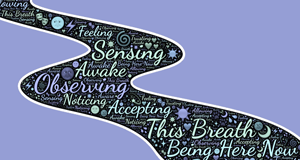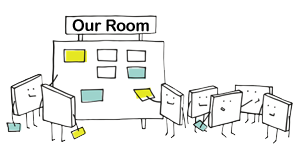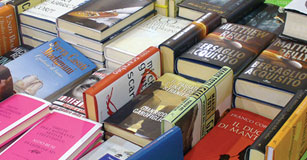Magical Metamorphosis: Butterfly Life Cycle Stories
Students explore the life cycle of a butterfly as they write and illustrate stories that show the stages of a butterfly’s metamorphosis.
Apps: Wixie®

Task
Most young children are familiar with butterflies and caterpillars and love to listen to stories about them, whether they are printed and found in the library or listened to online or using an iPad or tablet.
As budding scientists and authors, tell the students in your class that they are going to write and illustrate their own butterfly stories to teach younger students about the life cycle of a butterfly and get them excited about reading.
Engage
Ask students to indicate if they have all seen a butterfly and prompt them to describe what that butterfly looked like. Most will describe a butterfly in its adult stage.
Ask students if they have ever seen a caterpillar. Is that a butterfly? What about a chrysalis? Ask them to share what they think based on prior knowledge. While they may KNOW that a caterpillar will eventually turn into a butterfly, you may also want to challenge them to share how they could prove this information through scientific observation or experimentation.
Read a story that includes the various stages of a butterfly’s life cycle, such as the perennial favorite, The Very Hungry Caterpillar by Eric Carle. After reading, work as a class to identify the four stages of butterfly’s life cycle - eggs, caterpillar/larva, chrysalis/pupa, and adult.
As a group, brainstorm other ways a caterpillar might feel, such as sad, happy, scared, angry, jealous, or brave. You might want to use an idea cluster or character traits organizer. Might a butterfly’s or caterpillar’s feelings change at different stages of their life cycle?
If you want to evaluate student understanding before they begin writing, have them complete a butterfly life cycle organizer.
Create
Tell your young scientists and authors that they are going to write and illustrate their own butterfly life cycle stories! Go back and reread the list of feelings the class thought a butterfly or caterpillar could have. Have students choose one feeling to describe the main character in their story.
Share a character/setting/events organizer with each student. Have them write the feeling in the top of the character box. Students can then brainstorm ideas for setting and events. Remind students that events in their story need to make sense with the changes (events) in the butterfly’s life cycle.
Give the students a blank 4-stage cycle diagram to organizer their writing. Students can refer to the cycle diagram you created as a class or on their own to make sure they write about the stages correctly.
As students think about what might happen in their story, have them write words and simple ideas next to the boxes on the cycle diagram to describe what happens to their character during each stage of metamorphosis.

Let students know that their book will need to have at least one page for each stage in the life cycle. Have students develop a first draft of their story.
Ask students to read their rough draft three times and answer the following questions:
- Did I make each stage of life cycle of the butterfly clear?
- Will a reader like my story? Why?
- What pictures can I add to help tell the story?
Give students time to make edits to their rough draft. Students should also indicate which sentences will be on each page.
Next, have students use Wixie to design the final book. You can use the booklet template, create your own template, or simply show students how to add pages and text objects.
When sentences have been added to each page, have the students use the Paint tools to create illustrations for each page. You can show them how to use the Stickers as well if you want to save time during the illustration process.
If you are sharing the books in digital format, have students narrate the text on each page of the story. If you have lots of students working in a lab, you may want to use headset microphones to cut down on extra noise. You could also have students work on their narration at a center in your classroom set up for this purpose.
As they record, listen, and rerecord they gain valuable practice with reading fluency. The final product can also serve as an example of their fluency.
If you are publishing hard copies, have students click the Print button and choose how they want to share the story. If you are going to bind the pages into a book, then full size will work great. If you want to save paper or colored ink, you can also print at postcard size (4 to a page) and have students cut before binding.
If you are going share the books in digital form, have students use the Projects button to export the project to HTML, PDF, or video.
Share
Collect the final printer versions into a classroom or media center display or collect the digital versions into a collection on a page on your school or classroom website or even on iTunesU!
Celebrate with an author signing or reading event. Have younger students at the school stop by to read and enjoy the books as well as invite parents, grandparents, and community members to join you.
Assessment
At the beginning, you will have an easy opportunity to assess prior knowledge as you ask about butterfly sightings and discuss caterpillars. You can also evaluate analytical and creative thinking as they explain how they would investigate and prove that a caterpillar was also a butterfly. Assess comprehension about the process of metamorphosis and the various stages of a butterfly’s life cycle as your class, or individual student’s, develop a 4-cycle diagram.
Use the character/setting/events organizer and the 4-cycle diagram the students are using to organize their story to help you catch misconceptions. As students are writing the story, ask 5 W’s questions and 5 senses questions to help them write more than the basic facts.
As students begin illustrating their projects in Wixie, prompt them with questions about their story to encourage them to add more details and create more complete and specific illustrations. Each student’s voice narration will give you insight into oral proficiency and reading fluency.
Resources
Carle, Eric. The Very Hungry Caterpillar. ISBN: 0399213015
Deluise, Dom. Charlie the Caterpillar. ISBN: 0671796070
Krulik, Nancy. The Magic School Bus: Butterfly and the Bog Beast. ISBN: 0590508342
NeoK12 Metamorphosis Videos
Standards
Common Core Anchor Standards for Writing - Kindergarten
Text Types and Purposes
3. Use a combination of drawing, dictating, and writing to narrate a single event or several loosely linked events, tell about the events in the order in which they occurred, and provide a reaction to what happened.
Grades 1-2
3. Write narratives in which they recount two or more appropriately sequenced events, include some details regarding what happened, use temporal words to signal event order, and provide some sense of closure.
Kindergarten - Grade 2
Production and Distribution of Writing
With guidance and support from adults, explore a variety of digital tools to produce and publish writing, including in collaboration with peers.
Kindergarten
Speaking and Listening
Presentation of Knowledge and Ideas
5. Add drawings or other visual displays to descriptions as desired to provide additional detail.
Grade 1
5. Add drawings or other visual displays to descriptions when appropriate to clarify ideas, thoughts, and feelings.
Grade 2
5. Create audio recordings of stories or poems; add drawings or other visual displays to stories or recounts of experiences when appropriate to clarify ideas, thoughts, and feelings.
Next Generation Science Standards Grades K-2
Life Sciences
K-LS1-1 From Molecules to Organisms: Structures and Processes
Use observations to describe patterns of what plants and animals (including humans) need to survive.
1-LS1-2 From Molecules to Organisms: Structures and Processes
Read texts and use media to determine patterns in behavior of parents and offspring that help offspring survive.
1-LS3-1 Heredity: Inheritance and Variation of Traits
Make observations to construct an evidence-based account that young plants and animals are like, but not exactly like, their parents.
2-LS4-1 Biological Evolution: Unity and Diversity
Make observations of plants and animals to compare the diversity of life in different habitats.
ISTE NETS for Students 2016:
6. Creative Communicator
Students communicate clearly and express themselves creatively for a variety of purposes using the platforms, tools, styles, formats and digital media appropriate to their goals. Students:
a. choose the appropriate platforms and tools for meeting the desired objectives of their creation or communication.
b. create original works or responsibly repurpose or remix digital resources into new creations.
c. communicate complex ideas clearly and effectively by creating or using a variety of digital objects such as visualizations, models or simulations.
d. publish or present content that customizes the message and medium for their intended audiences.
>







